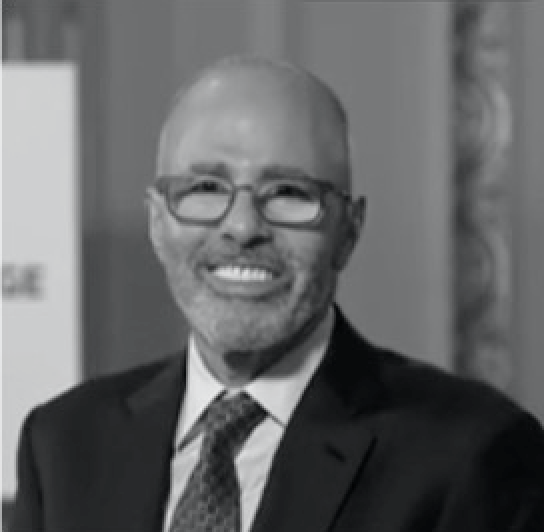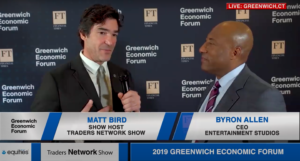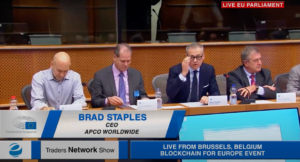Jim Nasr and Susan Ramonat on ‘Blockchain Enabled Cross Border Supply Chain’ at Converge2Xcelerate | Traders Network Show – Boston, MA
Contributed by: Show Editorial Team
Jim Nasr, VP of Technology and Innovation at Synchrogenix and Susan Ramonat, CEO of Spiritus at Converge2Xcelerate Conference (Boston, MA)
HIGHLIGHTS
- Blockchain technology in healthcare market expected to reach $42.1 million by 2023
- Medical devices have caused over 80,000 deaths since 2008
- Medical device industry is a $400 billion industry
FULL COVERAGE
INTERVIEW TRANSCRIPTS: Jim Nasr, VP of Technology & Innovation at Synchrogenix and Susan Ramonat, Founder/CEO of Spiritus
Jim Nasr – VP of Technology & innovation, Synchrogenix: 00:00
All right, everyone, this is a penultimate talk I think so. So you guys get some kind of award paid out in tokens to be decided in the future for your patience and perseverance. So I’ve known Susan for quite some time. I think that’s one of the few benefits of being old in my case. But on a serious note though is it’s been a number of years of kind of coming across each other in the healthcare and now healthcare and blockchain space. And you know, I’m really looking forward to kind of picking your brain a little bit about where are we with block chain in, at like a real like 1-on-1 do it today kind of thing. And then we’ll go from there. But before we do that, maybe just a little bit of a introduction from yourself. Sure. Alright. Yeah,
Susan Ramonat – Founder/CEO, Spiritus: 00:54
I’m actually a broken down old stockbroker. I started my career on wall street some 30 years ago, a career in enterprise sales, product development, spent some time on technology strategy. And then the last 10 years of that career working with banks and wealth managers where the company I was working for provided investment processing services and technology to support funds trading, securities, trading wealth management accounts, hedge fund, excuse me, hedge funds. I stood up an enterprise risk function in the wake of the financial crisis. And this is by way of example in illustration how I came to first be interested in distributed ledger, blockchain. But then also double back to healthcare and some of these specific issues around medical devices. I found our company Spiritus partners. We founded in early 2016 I was still working in finance.
Susan Ramonat – Founder/CEO, Spiritus: 01:55
We did quite a bit of market research and have actually just returned from two years in Scotland working with the national health service on a pilot with regards to the use case that we are focused on and we’ll spend some time talking about that, but we are concerned about the challenges around ensuring a medical device is safe and in good order at the point of care. It doesn’t sound like a big deal, but it actually turns out to be a very big deal when you crack that open. Across a wide range of devices. The complexity, the innovation that’s being introduced, some of the common challenge that’s exist across geographies around delivery of health services. Some of the underlying issues that we see her in the United States that, as you know, and in England and elsewhere are predominant and the service delivery models that folks are looking for. So as we peel this apart we’ll start to see sort of why and how, and then since this does bill as cross border supply chain, some of the challenges arise when you start to look at different jurisdictions and geographies in a distributed ledger implementation specifically. So I’ll stop with that.
Jim Nasr – VP of Technology & innovation, Synchrogenix: 03:07
That’s a good background. And yeah, there’s a lot we can just pry into, right? Right. From there. But, but let’s start simple. So, well, let’s like in even simpler step, you mentioned medical devices. That’s the world that you’re in with spirits is these days like in my mind, naively thinking that’s typically things I find in a clinic or hospital, you know, maybe nail down to the floor. But I’m kind of thinking that’s not really it. And maybe that’s kind of a misperception. Can you explain what does a medical device look like these days?
Susan Ramonat – Founder/CEO, Spiritus: 03:45
And it’s a definitional thing that has a regulatory and legal consequences. It’s everything from an infusion pump, a bed, a mattress a ventilator, a robotic surgical instrument. It could be an implantable defibrillator that’s software enabled and for that matter, software can be a medical device. Now under regulatory guidance. And relatedly, as we extend that out the AI and machine learning algorithms themselves would look to be regulated under the CDRH, the center for device and radiological health. The treatment of medical devices across that full range and continuum is a challenge. It’s been a challenge for a long period of time. So when you think about supply chain use cases that come to mind, pharma comes to mind and there’s a regulatory reason why we have the collaborations that we do, the projects that are occurring right now, the potential consortium that are going to arise in pharma.
Susan Ramonat – Founder/CEO, Spiritus: 04:45
It’s tied specifically to regulatory guidance. In the case of medical devices, there has been a challenge for a long time and that challenge continues to grow as the volumes and complexity of devices grows, volumes in terms of sheer numbers and numbers with patients, volumes in terms of the discrete use of devices or device combination with the diagnostic and therapeutics. This proliferation is creating a challenge because it’s very difficult to do two things. One is to trace in a supply chain sense up the supply chain if you, if you do have issues, but importantly down into the operating life of an asset which can extend over 10 years and infusion pump or a bed or a ventilator or for that matter, an implant may have an operating life of 10 years. And this is a fundamental distinction from the pharma use case.
Susan Ramonat – Founder/CEO, Spiritus: 05:39
When you crack that open and you say, what do I mean by safe and in good order at the point of care, it could be a mechanical issue, it could be something that’s wrong with a syringe set. It could be guidance to staff and training to staff as to how to calibrate the alarm system. It might be a software vulnerability or patch that needs to be and the parties and players that are involved in ensuring that device is safe and good ordering and maintenance and repair. Since a very, they varied by health system. They vary by device type. They vary based on contractual requirements and provisions. So I, clinical engineering team, biomedical technicians, medical physics staff that may be working with MRI machines or the like, they may in fact be working for the health system. On the other hand, they may be a manufacturer’s representative or certified representative, a technician that the manufacturer allows to perform the maintenance and repair activity.
Susan Ramonat – Founder/CEO, Spiritus: 06:35
The calibration. Likewise, the referred parties surfaces that outsource relationships with the health system. And here are the continuum of really is, could be across almost all assets. So now let’s start to introduce things like surgical instruments that requires sterilization or endoscopes. Many times they’ll have a central decontamination unit that’s off site. And so you’re physically moving surgical instruments, the trays offsite to decontaminate, sterilize, repackage, and bring into operating theater timely. There’s a lot of tracking issues with that. Not only the actual moving into the device, but the people process and technologies associated with getting the epidemiology, the microbiology right. And then therefore the sterile processes and decontamination. Endoscopes, oftentimes they’re handled within hospital and there’s units within the hospital. But again, it might be a third one, that’s actually doing that work.
Susan Ramonat – Founder/CEO, Spiritus: 07:31
So I’ve tried to bring out different types of devices to sort of start teasing at, wow, there’s a lot of complexity here. A lot of volumes and complexity, a lot of different players. Everything from mechanical issues and or parts issues right through the most abstract, a machine learning algorithm, right? All of those fit within this continuum of medical devices. And importantly this is not orthogonal at all. There is this move from acute care to clinic to home based care, preventive care and monitoring. So that’s the rich scene.
Jim Nasr – VP of Technology & innovation, Synchrogenix: 08:08
That is pretty rich. I almost regret asking the question. I’m just teasing. So I took a couple of key takeaways in my mind. One is that the definition of medical device really is quite amorphous these days, right? I mean, it’s in my world of software. So that’s the thing and obviously much of what’s being produced right now, it’s connected. So you could conceivably think of it as an IOMT internet medical device or IOT. You feel like that was the first takeaway. The second takeaway was that as you were going through the different scenarios, there is supply chain everywhere, right? Which we kind of know being in the healthcare and particularly the pharmaceutical industry. So as a segue you know, we hear a lot of things about blockchain and we’re here to talk about blockchain partially, you know, and there’s all these great things we can do, you know, anything from like enabling patients to monetize their data and data ownership and things like this. But where do you think is the beachhead? Like what can I do right now? Where did we send you and I, you know, we’re pumped. We leave this, you know, we’re going to go to the hotel, we’re going to start our new startup tonight. Where did we start?
Susan Ramonat – Founder/CEO, Spiritus: 09:29
The most mundane, right? Start with the mundane be audacious in your vision but pragmatic and where you step off. So literally, if I can track an infusion pump through its operating life there a fair amount of moving parts and the fact there are a lot of recalls and routine maintenance issues and they are at the center of operational efficiency and care delivery. Beds are the other thing. If you don’t have beds in infusion pumps besides nursing staff and doctors you really aren’t operating at some level actually beds go missing. That’s an interesting thing. Equipment gets loaned out to another facility that goes home with a patient and otherwise, so start with something now as your land and then how you expand. So in our case, we do expand to more clinical services areas. So all of neurology, right? And the right devices that are associated with that. Would you expand more comprehensively to operating theater? Okay.
Susan Ramonat – Founder/CEO, Spiritus: 10:38
ICU, general ward, care to clinic to home, you know, you, you sort of make decisions about where you’re doing that. But all with an eye to, I want to demonstrate out the value. In this case, the diamonds, the value is a consensus protocol, right? A shared registry. I’m going to put smart contracts and I’m going to put token economics to the side here for this use case and say, while I’m audacious, I’m also pragmatic. So I’m going to start with that mundane idea. Can I trace and verify not only the chain of custody but the service history, who did what, when, to what asset, under what auspices with what certifications and what are the artifacts and not to stations associated with that. That could be routine maintenance and repair. It could be inspection and testing activity that’s performed by an auditor, by a third party, by the joint commission.
Susan Ramonat – Founder/CEO, Spiritus: 11:30
Looking at records and being able to validate those records. It could be that third party that, that I was referring to that’s doing that work. It could be a remote patch that’s introduced. By way of going onto the software, distributed network of VPN and pulling down a patch. Okay. So start around something where now you can bring the hard part, the hard parts, not the technology hard part is what’s that minimum viable consortium. Who were the major players who would have a, an interest in and are there drivers beyond the wonder of the technology, providing them incentives to participate in this way? And that’s where we go back to the medical devices. I mentioned long, long supply chains. It often takes months, if not years, to recognize a pattern of events, incidents, injuries, complications and deaths. And as a manufacturer, quality affairs, regulatory affairs specialist to say, you know, I believe that’s attributable to our device.
Susan Ramonat – Founder/CEO, Spiritus: 12:37
What’s more, I think it’s the design where it’s this component that’s been manufactured for our behalf or third party or it’s in the sterile packaging or it’s and how it’s calibrated once it’s commissioned in hospital or it has to do with a guidance around battery replacement cycles or alerts or software. What would actually happen is that individual would have to go likely to their general counsel and say, I think I have an issue. All right, and then additional information will be sought and they will follow their regulatory obligations and certainly from a business interest. Now try to go back down the other direction, and again, I mentioned some of these assets have lives of, you know, several years, if not 10 or 12 years, how do I then identify the tail at the end and ensure that comprehensively that work has gotten done. So that’s a recall management use case.
Susan Ramonat – Founder/CEO, Spiritus: 13:32
It’s very challenging. Two illustrations. One would be that infusion pump example that I gave you, a syringe set that may have been associated with a manufacturing window from 2016 in the fall, you know, to late 2017 and they switched over to another manufacturer. What are you capitalizing on your capitalize on? Some things that regulators are very concerned about. First is the unique device identifier. So getting a start around a use cases. Do I have some driver that’s going to get identifier against this physical asset? Right. That’s a good thing to have. Are there standards out there, data standards associated with the identification of them? Well yeah, there are a GS one is a major provider for UT. What are known as UDI is for medical devices. They are more generally around physical products. There are standards they provide around location codes, product information.
Susan Ramonat – Founder/CEO, Spiritus: 14:28
So can you move to standards? That’s an important starting point. Are there standards, is there a data quality? Is there data, data governance issue? And now can we have a conversation among the different parties to say there’s a reason why we’re interested in improved post-market surveillance, which is the term that’s used and adverse event management. And that’s where the FDA day is driving. What’s known, the international medical device regulatory form IMDRF gets together every six months and locations. They are continually talking about how can we get common language around adverse events, how can we harmonize our regulations so that when a recall is issued in the United States, that information gets to the UK, gets to Australia, gets to other markets. So we don’t have some situations that we’ve had in recent years where something is well known in the United States and less well known elsewhere in there on this tree injuries and deaths.
Susan Ramonat – Founder/CEO, Spiritus: 15:20
So from a regulatory standpoint, whether it’s gathering real world evidence about the efficacy and performance of medical devices as an intervention, however defined that is where this post-market surveillance and adverse event management, there’s an interest in taking winds on high level of fragmentation and silos and a lot of complexity and getting that single service history and chain of custody. So let’s flip to the internet of medical things and connected devices. How much of a problem is this? It’s a big problem and a growing problem. A health system with say, several, several hospitals, clinics and otherwise may have an excess of a hundred thousand assets, a hundred thousand assets of which 20, 25% are connected. I works out to about 40 devices, the head of which 20, 25% are connected. Well, when I say connected, a net network connectable actually behind that is interoperability with a pharmacy system, with an EHR, with other devices that are some fashion algorithmically tied to one another, clusters of devices.
Susan Ramonat – Founder/CEO, Spiritus: 16:30
And the machine learning algorithms. So a leading health systems chief information security officer shared with the FDA. Now, almost three years ago. So the number’s grown that he had 25,000 connected devices, 25,000 connected, 6,000 unique makes models and versions and over a dozen operating systems. So he can do the math on that one in their matrix and say, how do I maintain visibility and transparency and a cadence and rhythm to ensure that I had the most current versions and to perform patches and upgrades. Oh, by the way, that’s compounded by the fact, as I said, it may not be my clinical engineering and biomedical engineering team that’s doing the work. It may be a manufacturer. He’s got certified representative that’s coming in and doing that work or providing remote patch or asking me to go to a VPN to download that patch.
Susan Ramonat – Founder/CEO, Spiritus: 17:30
It may be a third party who with whom I’ve contracted for the manufacturer’s contract to do the work. So when you sit back and look at clinical operations, that level of complexity in that lack of transparency becomes really compelling. The other thing I’ll offer is the unique, unique makes models and versions underneath that you have libraries and you know, network protocols and so on that are embedded in these, that may go back decades. Unfortunately, there was a significant software vulnerability identified called the urgent 11 that has come to light just in the last week, which has hospitals across the globe. Scrambling to understand underneath the covers is this embedded said network protocol related vulnerability that is at some level exploitable. You have to rate the exploitability of these things. You’re not running around patching everything but has health systems scrambling, trying to work with manufacturers.
Susan Ramonat – Founder/CEO, Spiritus: 18:32
And so there’s a concept known as the software bill of materials. And can I establish and maintain? And if I’m going to do that and this gets the IoMT piece and where we’re all going is it might be that sensor actually that’s in my home. Or that is on my asthma inhaler. That’s texting air quality, right. And providing input back. That sensor, maybe a, you know, I’ve only cost a few sentence and it’s got embedded protocol software libraries on it and potentially firmware. How do I identify and roll back and then roll forward out to that device at the point of care?
Jim Nasr – VP of Technology & innovation, Synchrogenix: 19:15
Wow. So wow. Somebody thinks the unpackaged cause that was, that was a lot, first of all we could have a symposium just going through this little use case of the hospital you were mentioning because so many things about that one are just wrong and bad and I wrote, I really are symbiotic of the world that we’re in and perhaps why we’re employed. At least I’m employed. But that’s a conversation for a different time. I’m just trying to cut up and calculate what you were talking about earlier in terms of kind of the beachhead. So I kind of think of it, given that we’re talking about cross border blockchain enabled supply chain, that really what you kind of alluded to and gave really good examples on where about compliance and transparency, right? Regulators are in a regulated world, whether we like it or not.
Jim Nasr – VP of Technology & innovation, Synchrogenix: 20:14
And we’re not the only ones. You know, it’s funny cause you know, my day is the CDC with public health and now pharma and healthcare, everybody thinks we are the most regulated industry. It turns out that is like so far not the case. You know, you look at construction, it’s highly regulated, more regulated education, highly rate. So it’s kind of a crutch. It’s used as a crutch isn’t it?
Susan Ramonat – Founder/CEO, Spiritus: 20:43
I came from financial services, so highly-regulated conversations and financial crisis.
Jim Nasr – VP of Technology & innovation, Synchrogenix: 20:50
Exactly. But so I think this whole thing of like we’re regulated, therefore we’re bound to be inefficient and really stupid about certain things. That’s just kind of a crazy thing, right.
Susan Ramonat – Founder/CEO, Spiritus: 20:56
Principle where I’m coming from. And I think those that have the, you know, the really commanding visions are extraordinary about where this technology might apply. I am down in the nuts and bolts, you know, back in the back office, worried about those safety and quality issues from the point of view of really all parties involved and see compliance as, as a tool and a mechanism that we have no doubt has risen really out of the last 150 to 200 years at least in health. Okay. Public health and otherwise I like to say we live in an administrative state, whether it’s the United States, the Commonwealth and the UK and Commonwealth countries. Foundationally you have a legislative branch and an executive branch that really interprets and makes policy based on that legislative guidance and what that legislative intensives and executes. So it’s the administrative state of the executive branch that executes, we have a judicial arm that can come be brought to bear from time to time.
Susan Ramonat – Founder/CEO, Spiritus: 21:58
And in the United States, our preferences to emphasize property rights and the interests therefore of corporations. Versus expert testimony or expertise. And there’s a tension in these areas like healthcare and life sciences, medical device regulation, farm regulation between the expertise that’s required. Right. And the property rights. And that tension manifests itself in really continually. And the FDA has real challenges with that. But I’m going to argue that regulators more generally do. I had the opportunity in November last year to run a workshop around regulatory experimentation for something called the community of federal regulators in Canada. They come together every year and talk about how Canada can promote the interest of its citizens safety environment, transport, education, finance, health but also the competitiveness of their economy and strike that right balance. So this topically was how might we experiment with some of these enabling technologies and my insight and I was actually joined by a gentleman from the UK, food safety division, I guess I would call her department, who had used distributed ledger to track meat and supply chain.
Susan Ramonat – Founder/CEO, Spiritus: 23:24
So he anchored on the provenance. Literally this, this specific cow moved from here to here to here and had these vaccinations. And it’s good to chop, to be blunt. It’s good to go into, into the supply chain. Okay. More broadly we’re bringing together, I know would have been fanatically the case, other enabling emerging technologies, right? So distributed ledger doesn’t ended up itself address all the issues. In this case, I am very optimistic at least from a compliance standpoint, whether it’s inspection testing and audit activities done on behalf of an organization that’s presented back to a regulator or just assurance of for the leadership teams and the stakeholders for the organizations that are at play, that that kind of assurance and reliability of the records will help us over time relieve some of the burden from a compliance standpoint, take regulations that were paper-based, right, and backward looking and provide greater level of assurance.
Susan Ramonat – Founder/CEO, Spiritus: 24:29
How do I know and understand that there’s the joint commission here or the care quality commission in the UK that that work has been done. You know, on the 150 infusion pumps that are in my inventory across three systems. How do I know and how can I be assured? I see that as real benefit. So it is at some level unambitious and mundane and some would say you’re enabling the existing players. I’m providing a level of transparency that is consistent with where the regulations are going. But it’s difficult to enable. And in that sense I’m optimistic over the next five or 10 years that there will be a drift back the other way and they’ll be able to relax some of these regulations based on that assurance.
Jim Nasr – VP of Technology & innovation, Synchrogenix: 25:16
Let’s hope so. So we’re just about out of time, but I have one more question for you because you raised the topic a bit earlier about how medical devices have evolving to suffer. So it turns out there is this saying software as a medical device yes. And the FDA’s is a proponent of and has had certain publications on. So tell me about that. You know, very briefly, where do you see it going?
Susan Ramonat – Founder/CEO, Spiritus: 25:41
Well, the tide’s not going to go back, that’s for sure. So we have guidance. We’ve had common T opportunity for common periods around what is, what fits within the bucket or not. We’ve made provisions for some of the large tech firms to be able to deliver digital health in a way where they’re not completely confined. It’s not, it’s not my lane to, to swim in at this point. But software is a medical device. That level of abstraction really does matter. Because you are going to ultimately draw diagnostic information and therapeutic decisions, you know, based on what that is. I would compliment that by saying that static software algorithm, right, is one thing and the opportunity to do the efficacy, performance, safety testing you can box that very well. It’s interesting just in the last several months the FDA has issued or if it’s preliminary propose framework for adaptive algorithms.
Susan Ramonat – Founder/CEO, Spiritus: 26:44
No, I look at that and I say, well, this is good, but they’re at the level of this would be good software life cycle management practice. That’s what they’re pointing to. What would good practice be? And rightly so, this is more consistent with the US based system being process oriented rather than prescriptive. So there’s going to be very important discussion, I think a three-way discussion between manufacturers, health specialists, health informatics specialists and clinicians otherwise and the regulators to say, what do we mean by that? How are we going to understand that? One of the areas that they are grounding down on what are the procedures for update? So I’ve trained an algorithm, how do I track the data sets that were used, the intermediate models that were used in a decision I made to then modify the algorithm for a broader population. This is a very important area of investigation.
Susan Ramonat – Founder/CEO, Spiritus: 27:41
The procedures around update was a very small part of the overall discussion, very much of it focused on what is it you’re trying to accomplish and can you demonstrate that? So be interested in to see how that plays out in the coming years and very important. And then if you’d double it back to the use case that we’re focused on. So if in fact that updated algorithm is released into the wild, so to speak, you know, how, how do I catch it on the other side? How do I catch it on the other side and know that,
Jim Nasr – VP of Technology & innovation, Synchrogenix: 28:14
And you can definitely see that being a blockchain play because it’s really irregulated information flow where you have to have compliance and transparency. It’s just not the way we normally think about it. Yeah. So that being fed, we had run out of time. Should we take some questions or are we DOA? Like I said. So we’ll take some questions and if there are no questions we will let you roam free. So yeah. Any questions from anyone? All right. Well, Susan, thank you so much as always. Thank you.
For Link to Original Article, Click Here
All rights reserved to the Traders Network Show. No part of this publication may be reproduced, distributed, or transmitted in any form or by any mean including; photocopying, recording, or other electronic or mechanical methods, without prior written permission of the publisher, except in the case of brief quotations embodied in critical reviews and certain other noncommercial uses permitted by copyright law. For permission requests, write to the publisher addressed “Attention: Permissions Coordinator”








